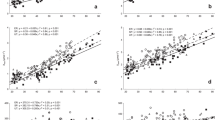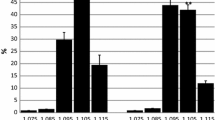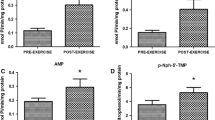Abstract
The present study aimed to investigate the acute effects of a single bout of high-intensive strength training on the production of cell-free plasma DNA (cf-DNA), as well as on the degradation of purine nucleotides as assessed by the concentration of xanthine (XA) and hypoxanthine (HX) in urine and serum. Twelve trained weightlifters performed six sets of six lifting exercises with 90–95% of the one repetition maximum. Blood samples and urine were obtained 1 h before training, immediately after finishing the exercise session and following 2 h of recovery. Cf-DNA, HX, and XA (in serum) significantly increased (P < 0.05–P < 0.001) immediately after heavy lifting exercise when compared with baseline levels, and significantly decreased (P < 0.05–P < 0.001) after 2 h of recovery. These results indicate that, cf-DNA and oxypurines might be relevant biomarkers for cellular damage, mechanical, energetic, and/or ischemic stress in context with exercise.



Similar content being viewed by others
References
Armstrong RB (1990) Initial events in exercise-induced muscular injury. Med Sci Sports Exerc 22:429–435
Atamaniuk J, Vidotto C, Tschan H, Bachl N, Stuhlmeier KM, Muller MM (2004) Increased concentrations of cell-free plasma DNA after exhaustive exercise. Clin Chem 50:1668–1670
Atamaniuk J, Ruzicka K, Stuhlmeier KM, Karimi A, Eigner M, Mueller MM (2006) Cell-free plasma DNA: a marker for apoptosis during hemodialysis. Clin Chem 52:523–526
Atamaniuk J, Stuhlmeier KM, Vidotto C, Tschan H, Dossenbach-Glaninger A, Mueller MM (2008) Effects of ultra-marathon on circulating DNA and mRNA expression of pro- and anti-apoptotic genes in mononuclear cells. Eur J Appl Physiol 24:24
Avent ND, Madgett TE, Maddocks DG, Soothill PW (2009) Cell-free fetal DNA in the maternal serum and plasma: current and evolving applications. Curr Opin Obstet Gynecol 21:175–179
Bloomer RJ (2008) Effect of exercise on oxidative stress biomarkers. Adv Clin Chem 46:1–50
Chu T, Bunce K, Hogge WA, Peters DG (2009) Statistical model for whole genome sequencing and its application to minimally invasive diagnosis of fetal genetic disease. Bioinformatics 23:23
Destouni A, Vrettou C, Antonatos D, Chouliaras G, Traeger-Synodinos J, Patsilinakos S, Kitsiou-Tzeli S, Tsigas D, Kanavakis E (2009) Cell-free DNA levels in acute myocardial infarction patients during hospitalization. Acta Cardiol 64:51–57
Fatouros IG, Destouni A, Margonis K, Jamurtas AZ, Vrettou C, Kouretas D, Mastorakos G, Mitrakou A, Taxildaris K, Kanavakis E, Papassotiriou I (2006) Cell-free plasma DNA as a novel marker of aseptic inflammation severity related to exercise overtraining. Clin Chem 52:1820–1824 (Epub 2006 Jul 13)
Fisher-Wellman K, Bloomer RJ (2009) Acute exercise and oxidative stress: a 30 year history. Dyn Med 8:1
Gornik I, Wagner J, Gasparovic V, Lauc G, Gornik O (2009) Free serum DNA is an early predictor of severity in acute pancreatitis. Clin Biochem 42:38–43 (Epub 2008 Nov 1)
Hellsten Y, Ahlborg G, Jensen-Urstad M, Sjodin B (1988) Indication of in vivo xanthine oxidase activity in human skeletal muscle during exercise. Acta Physiol Scand 134:159–160
Hellsten Y, Hansson HA, Johnson L, Frandsen U, Sjodin B (1996) Increased expression of xanthine oxidase and insulin-like growth factor I (IGF-I) immunoreactivity in skeletal muscle after strenuous exercise in humans. Acta Physiol Scand 157:191–197
McCord JM (1985) Oxygen-derived free radicals in postischemic tissue injury. N Engl J Med 312:159–163
McDonagh MJ, Davies CT (1984) Adaptive response of mammalian skeletal muscle to exercise with high loads. Eur J Appl Physiol Occup Physiol 52:139–155
Nikolaidis MG, Paschalis V, Giakas G, Fatouros IG, Koutedakis Y, Kouretas D, Jamurtas AZ (2007) Decreased blood oxidative stress after repeated muscle-damaging exercise. Med Sci Sports Exerc 39:1080–1089
Nikolaidis MG, Jamurtas AZ, Paschalis V, Fatouros IG, Koutedakis Y, Kouretas D (2008) The effect of muscle-damaging exercise on blood and skeletal muscle oxidative stress: magnitude and time-course considerations. Sports Med 38:579–606
Park KU, Lee HE, Park DJ, Jung EJ, Song J, Kim HH, Choe G, Kim WH, Lee HS (2009) MYC quantitation in cell-free plasma DNA by real-time PCR for gastric cancer diagnosis. Clin Chem Lab Med 23:23
Peake J, Nosaka K, Suzuki K (2005) Characterization of inflammatory responses to eccentric exercise in humans. Exerc Immunol Rev 11:64–85
Peake JM, Nosaka K, Muthalib M, Suzuki K (2006) Systemic inflammatory responses to maximal versus submaximal lengthening contractions of the elbow flexors. Exerc Immunol Rev 12:72–85
Rietjens SJ, Beelen M, Koopman R, VANL LJ, Bast A, Haenen GR (2007) A single session of resistance exercise induces oxidative damage in untrained men. Med Sci Sports Exerc 39:2145–2151
Sahlin K, Tonkonogi M, Soderlund K (1999) Plasma hypoxanthine and ammonia in humans during prolonged exercise. Eur J Appl Physiol Occup Physiol 80:417–422
Saukkonen K, Lakkisto P, Pettila V, Varpula M, Karlsson S, Ruokonen E, Pulkki K (2008) Cell-free plasma DNA as a predictor of outcome in severe sepsis and septic shock. Clin Chem 54:1000–1007 (Epub 2008 Apr 17)
Schwarzenbach H, Stoehlmacher J, Pantel K, Goekkurt E (2008) Detection and monitoring of cell-free DNA in blood of patients with colorectal cancer. Ann N Y Acad Sci 1137:190–196
Schwarzenbach H, Alix-Panabieres C, Muller I, Letang N, Vendrell JP, Rebillard X, Pantel K (2009) Cell-free tumor DNA in blood plasma as a marker for circulating tumor cells in prostate cancer. Clin Cancer Res 15:1032–1038
Sjodin B, Hellsten Westing Y, Apple FS (1990) Biochemical mechanisms for oxygen free radical formation during exercise. Sports Med 10:236–254
Spiering BA, Kraemer WJ, Hatfield DL, Vingren JL, Fragala MS, Ho JY, Thomas GA, Hakkinen K, Volek JS (2008) Effects of l-carnitine l-tartrate supplementation on muscle oxygenation responses to resistance exercise. J Strength Cond Res 22:1130–1135
Stathis CG, Zhao S, Carey MF, Snow RJ (1999) Purine loss after repeated sprint bouts in humans. J Appl Physiol 87:2037–2042
Tamaki T, Uchiyama S, Tamura T, Nakano S (1994) Changes in muscle oxygenation during weight-lifting exercise. Eur J Appl Physiol Occup Physiol 68:465–469
Tong YK, Lo YM (2006) Diagnostic developments involving cell-free (circulating) nucleic acids. Clin Chim Acta 363:187–196 (Epub 2005 Aug 26)
Turgan N, Boydak B, Habif S, Gulter C, Senol B, Mutaf I, Ozmen D, Bayindir O (1999) Urinary hypoxanthine and xanthine levels in acute coronary syndromes. Int J Clin Lab Res 29:162–165
Uchiyama S, Tsukamoto H, Yoshimura S, Tamaki T (2006) Relationship between oxidative stress in muscle tissue and weight-lifting-induced muscle damage. Pflugers Arch 452(1):109–116 (Epub 2006 Jan 10)
Vidotto C, Fousert D, Akkermann M, Griesmacher A, Muller MM (2003) Purine and pyrimidine metabolites in children’s urine. Clin Chim Acta 335:27–32
Virag L, Szabo C (2001) Purines inhibit poly(ADP-ribose) polymerase activation and modulate oxidant-induced cell death. Faseb J 15:99–107
Volek JS, Kraemer WJ, Rubin MR, Gomez AL, Ratamess NA, Gaynor P (2002) l-Carnitine l-tartrate supplementation favorably affects markers of recovery from exercise stress. Am J Physiol Endocrinol Metab 282:E474–E482
Vollaard NB, Shearman JP, Cooper CE (2005) Exercise-induced oxidative stress: myths, realities and physiological relevance. Sports Med 35:1045–1062
Vollaard NB, Cooper CE, Shearman JP (2006) Exercise-induced oxidative stress in overload training and tapering. Med Sci Sports Exerc 38:1335–1341
Westing YH, Ekblom B, Sjodin B (1989) The metabolic relation between hypoxanthine and uric acid in man following maximal short-distance running. Acta Physiol Scand 137:341–345
Xue X, Teare MD, Holen I, Zhu YM, Woll PJ (2009) Optimizing the yield and utility of circulating cell-free DNA from plasma and serum. Clin Chim Acta 10:10
Yoon KA, Park S, Lee SH, Kim JH, Lee JS (2009) Comparison of circulating plasma DNA levels between lung cancer patients and healthy controls. J Mol Diagn 26:26
Zieliński J, Rychlewski T, Kusy K, Domaszewska K, Laurentowska M (2009) The effect of endurance training on changes in purine metabolism: a longitudinal study of competitive long-distance runners. Eur J Appl Physiol 106:867–876 (Epub 2009 May 29)
Zitt M, Muller HM, Rochel M, Schwendinger V, Goebel G, Devries A, Margreiter R, Oberwalder M, Zeillinger R, Ofner D (2008) Circulating cell-free DNA in plasma of locally advanced rectal cancer patients undergoing preoperative chemoradiation: a potential diagnostic tool for therapy monitoring. Dis Markers 25:159–165
Author information
Authors and Affiliations
Corresponding author
Additional information
Communicated by Susan Ward.
Rights and permissions
About this article
Cite this article
Atamaniuk, J., Vidotto, C., Kinzlbauer, M. et al. Cell-free plasma DNA and purine nucleotide degradation markers following weightlifting exercise. Eur J Appl Physiol 110, 695–701 (2010). https://doi.org/10.1007/s00421-010-1532-5
Accepted:
Published:
Issue Date:
DOI: https://doi.org/10.1007/s00421-010-1532-5




